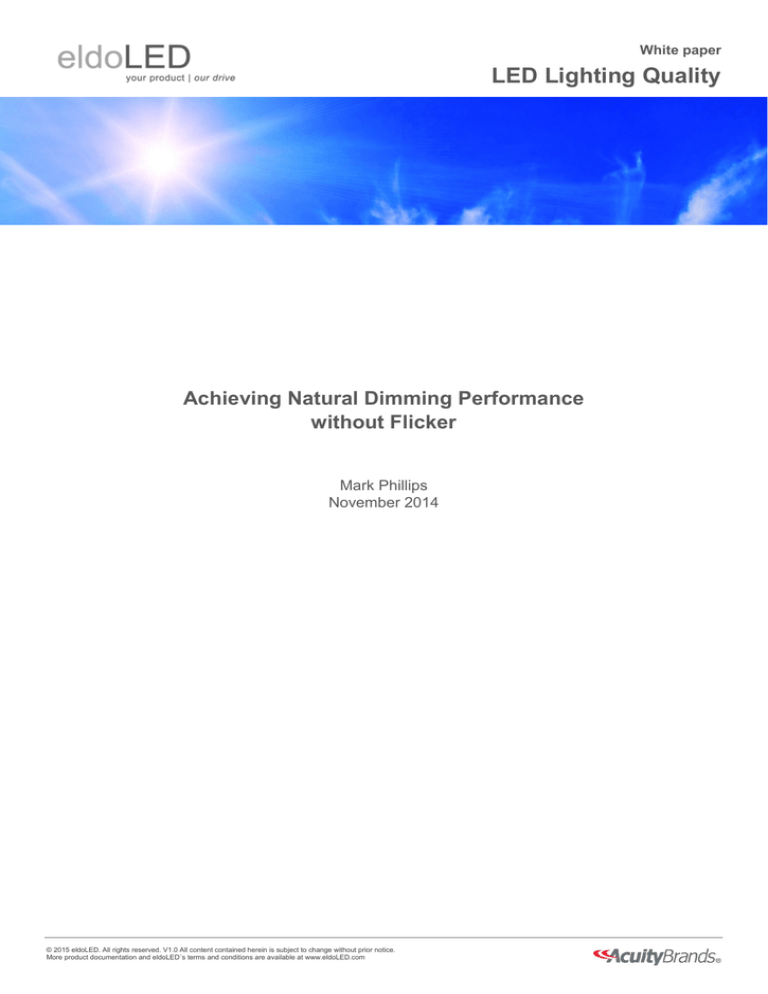
White paper
LED Lighting Quality
Achieving Natural Dimming Performance
without Flicker
Mark Phillips
November 2014
© 2015 eldoLED. All rights reserved. V1.0 All content contained herein is subject to change without prior notice.
More product documentation and eldoLED´s terms and conditions are available at www.eldoLED.com
Table of Contents
1. Abstract
3
2. Dimming LEDs
4
3. Achieving Natural Dimming Performance
5
3.1 Smoothness of light output
5
3.2 Light Level
6
3.3 Flicker-free
7
4. LED Systems
9
5. How to Realize the Full Promise of LED Lighting and Natural Dimming
11
About eldoLED
12
References
13
2
1. Abstract
LED lighting has arrived in the mainstream market but challenges with light quality and flicker still remain. LED technology is continually changing
and is far superior to that of the traditional sources like incandescent and halogen. This paper will address how to achieve the natural dimming
characteristics of traditional light sources using LED technology.
3
2. Dimming LEDs
The adoption of LED lighting has grown rapidly over the last few years primarily because of the higher efficacy and increased energy efficiency
LEDs have over traditional light sources. Lighting control and dimming have always been a part of these traditional sources and must continue to be
part of LED technology. A system approach must be understood when implementing LED control, meaning, knowledge of control, driver, LED and
luminaire are necessary for success.
Dimming LEDs enables the designer and end user to create an emotion or build an experience within a space all while reducing energy
consumption. LED technology enables features beyond what traditional light sources can offer because of inherent digital characteristics. This
poses both challenges as well as opportunities and understanding the tools you have to work with (control, driver, and LED) can enable exciting
solutions never experienced with traditional light sources (i.e. Visible Light Communication).
There are certain characteristics of the traditional sources that have been taken for granted with LED technology, and rightfully so. Characteristics
such as quick turn on, color stability, and smooth flicker-free dimming from full output to off have taken a back seat to efficacy (lumens per watt) and
longer life times in LEDs. But with such advancement in technology, an experience of LED lighting should encompass not just efficiency and lifetime
but the natural characteristics of the traditional light sources.
4
3. Achieving Natural Dimming Performance
The characteristics of LED lighting that need consideration for producing natural dimming performance are the smoothness of the dimming curve,
flicker or lack thereof, the capability to produce light without LED color shift and also the capability to mimic the blackbody curve while dimming.
Again, we must look at this from a systems approach and understand what each of the components within the system is capable of.
3.1 Smoothness of Light Output
To address dimming smoothness we must understand the digital nature of an LED and LED driver. In order to shift from one light level to another
the output must step, and that step size is critical to the visual experience. To ensure natural dimming performance the driver should step the LED
from 100% light output to its low end light level without noticeable change. The human eye can detect a change greater than 3% of green
wavelength light (most visible to the naked eye, 550 nm), so we must change at a rate of less than 3% (i.e. 0.1% light level to 0.103% will not be
noticed as a step but a smooth transition – see graph below).
The next consideration is the resolution at which the LED dims, since the LED responds instantaneously to current changes and doesn’t receive a
dampening effect that an incandescent filament provides. In order for the light level to transition smoothly, the control and driver must have enough
steps so the eye does not perceive the change. The minimum amount of steps from 100% light output to low end is 65,536, which is 16 bit
resolution. Notice the difference in the graphs below indicating what may be perceived when different resolutions are implemented (2 bit vs 16 bit).
Resolution is the number of steps between 0% and 100% brightness:
5
3.2 Light Level
Below is a chart that shows the relationship of measured power (similar to measured light) versus perceived light (blue line). This is an important
distinction to make with LEDs since achieving low stable light levels is often a challenge. With traditional incandescent and halogen sources this
was not an issue because they were able to dim smoothly to very low perceived light levels. Again, LEDs are much more advanced than
incandescent lamps and they should be able to perform as well, if not better. To ensure natural performance and high quality dimming occurs within
the luminaire, an appropriate LED driver must be selected. We will describe what considerations should be made when choosing the right LED
driver.
Measured power vs perceived light
6
3.2 Flicker
A major issue plaguing the LED lighting industry today is flicker but not simply flicker that is easily perceived. The Illuminating Engineering Society
of North America (IESNA) Lighting Handbook defines it as the “rapid variation in light source intensity” (Rea, 2000). Virtually every light source
powered from an AC line will have some type of modulated signal.
The flicker that is presented in this document is photometric flicker. Flicker generated from line noise or transients may be considered flicker but not
photometric and not covered in-depth in this paper.
There are two primary types of photometric flicker: visible and stroboscopic. Visible flicker is consciously perceivable by the human viewer and
objectionable to all. Stroboscopic flicker is not consciously perceived and may have biological effects on the human person. Stroboscopic flicker has
a greater impact on children, migraine headache sufferers, and individuals with epilepsy and autism.
Stroboscopic flicker is primarily generated by an LED dimming method called Pulse-Width Modulation (PWM). PWM cycles the LED from maximum
current to zero current and repeats it at a rate, ideally, higher than what is typically perceived, about 800 Hz. This PWM signal is generated by the
LED driver. Knowing what technology a driver uses to dim the LED will help to understand if flicker will be present in a luminaire. The image below
plots where light sources fall in terms percent flicker and flicker frequency and how that corresponds to the risks associated with flicker.
A luminaire should be in compliance with the characteristics below to be considered flicker free.
Light Level
100%-10%
10%-5%
1%
0.1%
Percent Flicker
<25%
<100%
100%
100%
Minimum Modulation Frequency
>10kHz
>10kHz
>1000Hz
>1000Hz
There are a few ways to identify if flicker may be present but the easiest way is with a pencil. If you wave a pencil in front of the LED source and it
doesn’t appear as a complete blur then chances are flicker is present.
7
The IES has provided guidelines to quantify how much flicker is present within a luminaire. While manufacturers are not yet required to provide this
information it is incumbent upon the designer or user to request it.
8
4. LED Systems
Again, the LED system is made up of the control/dimmer, the LED driver, the LED chips or module and the luminaire. To achieve natural flicker-free
control of the LED, it is important to ensure those four components are compatible and especially that the right LED driver is selected.
Some controls may only have a few hundred to one thousand set points, which will affect the dimming performance of the LED. Some LED drivers
can perform a function of interpolation, which digitally adds steps from one set point of the dimmer to another, assuring a smooth transition from one
output level to the next.
The LED driver is typically connected to a power source and also to a control but when a phase controlled driver is used then the power and signal
are coincident. Drivers may support a variety of controls: 0-10V, Forward/Reverse Phase, DALI, DMX/RDM. The driver produces a regulated control
signal to the LED. This regulated signal from the output of the driver determines the level of performance you will see.
9
The images below describe the pros and cons of different LED dimming methods. Their usage is dependent on manufacturers’ preference if not
specified. PWM is typically most cost-effective so it is most often used.
Pulse Width Modulation (PWM)
Constant LED current, varying LED on/off times
Good dimming regulation at deep dimming levels
Little color shift when dimming
Potential noise generation
Potentially undesirable flicker, depending on frequency
Constant Current Reduction (CCR)
Varying LED current, varying LED always on
No flicker
Higher LED efficacy at lower dimming levels
No noise generation
Poor dimming regulation at deep dimming levels
Color shift may occur with phosphor converted LEDs
Hybrid Dimming
Varying LED current, duty cycle and frequency on small current range
No LED on/off times
Best dimming regulation at deep dimming levels
High frequency operation
(mixing frequencies between 1KHz and 20KHz)
No flicker
Low noise generation
Little color shift when dimming
10
5. How to Realize the Full Promise of LED Lighting
and Natural Dimming
Understand the application requirements and set an expectation for the customer, natural dimming is possible if correct technology is
implemented
11
Know what components will make up your system (control, driver, LED)
Consider the driver and its capabilities, know which type the fixture manufacturer is using
Ask about its flicker percentage or index, know what perceived light level it can dim down to and what the dimming resolution is
Ask the luminaire manufacturer for a driver that meets your requirements
About eldoLED
eldoLED is a world leader in the design and manufacture of intelligent drive solutions for LED based lighting systems. Our technologies empower
our customers to deliver the promise of LED lighting: smarter, sleeker and more efficient systems to meet the needs of an ever more energy
conscious world. Colour is our nature, Light is our passion, your product our drive.
Products
eldoLED offers a continuously expanding range of programmable, intelligent LED drivers. With in-house R&D and manufacturing, eldoLED is well
positioned to deliver leading solutions fast and high quality.
Customer Commitment
Continuous technological innovation and the commitment to help our customers bring solid-state applications to a higher level are two important
pillars of our company.
Europe, Rest of World
North America
eldoLED B.V.
eldoLED America
Science Park Eindhoven 5125
One Lithonia Way
5692 ED Son
Conyers, GA 30012
The Netherlands
USA
T: 00 31 (0)40 7820400
T: 00 1 877 353 6533
E: info@eldoled.com
E: info@eldoled.com
W: www.eldoled.com
W www.eldoled.com
12
References
ASSIST. ASSIST recommends...Flicker Parameters for Reducing Stroboscopic Effects from Solid-state Lighting Systems. Volume 11, Issue 1.
Lighting Research Center: Troy, N.Y., 2012.
M.S. Rea, ed. The IESNA Lighting Handbook: Reference & Application, 9th Edition. Illuminating Engineering Society of North America, New York,
2000.
N. Miller and M. Poplawski. Exploring flicker in Solid State Lighting: What you might find, and how to deal with it, Pacific northwest National
Laboratory, 2011.
13






